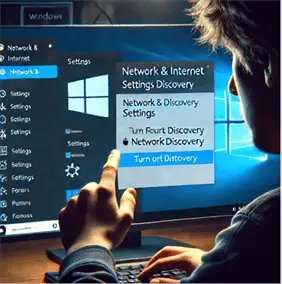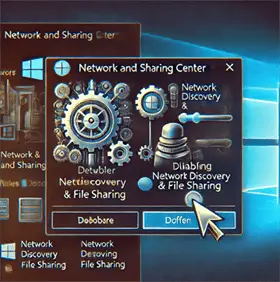Turn Off Network Discovery and File Sharing Windows 10: The Ultimate Guide
Discover expert methods to Turn Off Network Discovery and File Sharing Windows 10. Protect your data with our comprehensive tutorial.
Are you concerned about your Windows 10 PC’s security? Do you want to prevent unauthorized access to your files and printer? Then you’ve come to the right place. In this comprehensive guide, we’ll walk you through the process of turning off network discovery and file sharing in Windows 10, helping you enhance your system’s security and maintain control over your shared resources.
Introduction: Why Turn Off Network Discovery and File Sharing?
In today’s interconnected world, protecting your digital assets is more crucial than ever. Windows 10’s network discovery and file sharing features are designed to make collaboration easier, but they can also expose your system to potential security risks. By disabling these features, you can significantly reduce your attack surface and keep your data safe from prying eyes.
Whether you’re a home user looking to secure your personal files or an IT professional managing a network of computers, understanding how to control network discovery and file sharing is essential. This guide will provide you with step-by-step instructions, command-line alternatives, and best practices to help you make informed decisions about your Windows 10 security settings.
Understanding Network Discovery and File Sharing
Before we dive into the process of turning off these features, let’s briefly explain what they do:
- Network Discovery: This feature allows your Windows 10 PC to find other devices on the network and be found by them. When enabled, your computer can see and be seen by other network-connected devices.
- File and Printer Sharing: This feature allows other users on the network to access shared folders and printers on your computer. When enabled, you can share resources with other network users.
While these features can be convenient in certain scenarios, they can also pose security risks, especially on public or untrusted networks.
Step-by-Step Guide: Turn Off Network Discovery and File Sharing Windows 10

Follow these steps to disable network discovery and file sharing on your Windows 10 PC:
Step 1: Open Network & Internet Settings
- Right-click on the Network Status icon in the system tray (bottom-right corner of your screen).
- Select “Open Network & Internet settings” from the context menu.
Step 2: Access Network and Sharing Center
- In the Network & Internet settings window, scroll down to the “Advanced network settings” section.
- Click on “Network and Sharing Center”.
Step 3: Change Advanced Sharing Settings
- In the Network and Sharing Center, click on “Change advanced sharing settings” in the left sidebar.
Step 4: Turn Off Network Discovery and File Sharing
- Expand the “Private” profile settings (or the profile that matches your current network type).
- Under “Network discovery”, select “Turn off network discovery”.
- Under “File and printer sharing”, select “Turn off file and printer sharing”.
- Scroll down and click “Save changes”.
Note: If you’re using a standard user account, you may be prompted for an administrator password to confirm these changes.
Alternative Method: Using Command Prompt
For those who prefer using the command line or need to automate the process, you can use the following commands to disable network discovery and file sharing:
Disable Network Discovery via Command Prompt
- Open Command Prompt as an administrator.
- Type the following command and press Enter:
netsh advfirewall firewall set rule group=”Network Discovery” new enable=No
netsh advfirewall firewall set rule group="Network Discovery" new enable=NoDisable File and Printer Sharing via Command Prompt
- In the same Command Prompt window, type the following command and press Enter:
netsh advfirewall firewall set rule group=”File and Printer Sharing” new enable=No
netsh advfirewall firewall set rule group="File and Printer Sharing" new enable=NoThese commands will disable the respective features by modifying the Windows Firewall rules.

Group Policy Method: Disable Network Discovery and File Sharing
For IT administrators managing multiple computers in a domain environment, using Group Policy is an efficient way to control network discovery and file sharing settings:
- Open the Group Policy Management Console (gpmc.msc).
- Create or edit a Group Policy Object (GPO) linked to the desired Organizational Unit (OU).
- Navigate to Computer Configuration > Policies > Windows Settings > Security Settings > Network List Manager Policies.
- Configure the “Network Discovery” and “File and Printer Sharing” settings as desired.
This method allows for centralized management of these settings across multiple Windows 10 machines.
Verifying Your Settings
After making changes, it’s important to verify that network discovery and file sharing have been successfully disabled:
- Open File Explorer.
- Click on “Network” in the left sidebar.
- If network discovery is turned off, you should see a message stating, “Network discovery is turned off. Network computers and devices are not visible. Click to change.”
Additionally, you can check your advanced firewall settings:
- Open Command Prompt as an administrator.
- Type the following command and press Enter:
netsh advfirewall show allprofiles
netsh advfirewall show allprofilesLook for the “File and Printer Sharing” and “Network Discovery” entries in the output. They should be listed as “Disabled” if you’ve successfully turned them off.
When to Keep Network Discovery and File Sharing Enabled
While disabling network discovery and file sharing enhances security, there are situations where you might want to keep these features enabled:
- Home Networks: If you frequently share files or printers with other devices on your home network, you may want to keep these features on for convenience.
- Small Office Settings: In small office environments where collaboration is essential, network discovery and file sharing can improve productivity.
- Media Streaming: If you use your Windows 10 PC as a media server, you’ll need these features enabled for other devices to access your media library.
In these cases, consider using Windows 10’s network profile settings to enable these features only on trusted networks.
Best Practices for Network Security
Turning off network discovery and file sharing is just one aspect of maintaining a secure Windows 10 system. Here are some additional best practices to consider:
- Keep Your System Updated: Regularly install Windows updates to patch security vulnerabilities.
- Use a Firewall: Ensure Windows Defender Firewall is enabled and properly configured.
- Install Antivirus Software: Use Windows Defender or a third-party antivirus solution to protect against malware.
- Enable BitLocker: Encrypt your hard drive to protect your data if your device is lost or stolen.
- Use Strong Passwords: Implement complex passwords and consider using a password manager.
- Be Cautious on Public Networks: Avoid accessing sensitive information when connected to public Wi-Fi.
Troubleshooting Common Issues
Sometimes, you may encounter issues when trying to turn off network discovery and file sharing. Here are some common problems and their solutions:
Problem: Settings Revert After Reboot
If you find that your network discovery and file sharing settings keep turning back on after a system restart, it could be due to:
- Windows Updates: Some updates may reset these settings.
- Third-party software: Certain applications may be modifying your network settings.
Solution: Use Group Policy or registry edits to enforce your preferred settings.
Problem: Unable to Change Settings
If you’re unable to modify network discovery and file sharing settings, it could be due to:
- Insufficient permissions: You may not have administrative rights.
- Group Policy restrictions: Your organization may have enforced certain settings.
Solution: Contact your system administrator or use an administrative account to make changes.
Problem: Network Connectivity Issues
After disabling network discovery and file sharing, you may experience connectivity problems with certain applications or devices.
Solution: Review your application requirements and consider selectively enabling necessary features or creating specific firewall rules.
Frequently Asked Questions (FAQ)
- Q: Is it safe to turn off network discovery and file sharing? A: Yes, it’s generally safe and can improve your system’s security, especially on public networks.
- Q: Will turning off network discovery affect my internet connection? A: No, it won’t affect your ability to browse the internet or use online services.
- Q: How do I turn network discovery back on if I need it? A: Follow the same steps outlined in this guide, but select “Turn on network discovery” instead.
- Q: Can I selectively enable file sharing for specific folders? A: Yes, you can right-click on a folder, select “Properties,” go to the “Sharing” tab, and configure sharing options.
- Q: Does disabling these features affect Remote Desktop connections? A: No, Remote Desktop uses a different protocol and is not affected by these settings.
- Q: Will turning off file sharing prevent me from accessing network drives? A: No, you can still access network drives. This setting only prevents others from accessing your shared resources.
- Q: How often should I review my network discovery and file sharing settings? A: It’s a good practice to review these settings after major Windows updates or when you connect to new networks.
- Q: Can I use PowerShell to manage these settings? A: Yes, PowerShell provides cmdlets to manage Windows Firewall rules, including those for network discovery and file sharing.
- Q: Are there any risks to disabling network discovery and file sharing? A: The main risk is potential inconvenience if you need to share files or printers on your local network.
- Q: How do these settings interact with VPN connections? A: VPN connections typically use their own protocols and are not directly affected by these settings.
Key Takeaways
- Turning off network discovery and file sharing in Windows 10 can significantly enhance your system’s security.
- You can disable these features through the GUI, Command Prompt, or Group Policy.
- Consider your specific use case before disabling these features, as they may be necessary for home or small office networks.
- Regularly review and update your network security settings to maintain optimal protection.
- Combine this practice with other security measures like keeping your system updated and using strong passwords.
By following this guide, you’ve taken an important step in securing your Windows 10 PC. Remember, cybersecurity is an ongoing process, so stay informed about the latest threats and best practices to keep your digital life safe and secure.
It’s more likely that you would only want to “Turn Off Network Discovery and File Sharing Windows 10” if your computer is a standalone PC.






